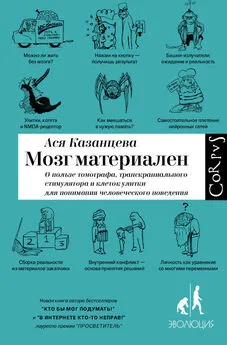Анастасия Казанцева - В интернете кто-то неправ!
- Название:В интернете кто-то неправ!
- Автор:
- Жанр:
- Издательство:АСТ : CORPUS
- Год:2016
- Город:Москва
- ISBN:978-5-17-092181-2
- Рейтинг:
- Избранное:Добавить в избранное
-
Отзывы:
-
Ваша оценка:
Анастасия Казанцева - В интернете кто-то неправ! краткое содержание
Первую книгу Аси Казанцевой «Кто бы мог подумать? Как мозг заставляет нас делать глупости» высоко оценили ученые и обычные читатели — уже несколько лет она остается бестселлером. В 2014 году книга была удостоена премии «Просветитель». Во всем, что делает Ася, будь то научно-популярные лекции, статьи или книги, проявляется ее редкое умение доступно и увлекательно говорить о сложном, не упрощая и не изменяя научному подходу.
В интернете кто-то неправ! - читать онлайн бесплатно ознакомительный отрывок
Интервал:
Закладка:
5 Smith S. et al. The effects of contact on sexual prejudice: a meta-analysis // Sex Roles , Aug. 2009, Vol. 61, Issue 3–4, 178–191.
6 Kendler K. et al. Sexual orientation in a U.S. national sample of twin and nontwin sibling pairs // American Journal of Psychiatry , Nov. 2000, Vol. 157(11), 1843–1846.
7 Michael B. et al. Genetic and environmental infuenc-es on sexual orientation and its correlates in an Australian twin sample // Journal of Personality and Social Psychology , Mar. 2000, Vol. 78(3), 524–536.
8 Langstrom N. et al. Genetic and environmental effects on same-sex sexual behavior: a population study of twins in Sweden // Archives of Sexual Behavior , Feb. 2010, Vol. 39(1), 75–80.
9 Hamer D. et al. A linkage between DNA markers on the X chromosome and male sexual orientation // Science , July 1993, Vol. 16, 261(5119), 321–327.
10 Sanders A. et al. Genome-wide scan demonstrates significant linkage for male sexual orientation // Psychological Medicine , 2015 May, Vol. 45(7), 1379–1388.
11 Camperio Ciani A. and Pellizzari E. Fecundity of paternal and maternal non-parental female relatives of homosexual and heterosexual men // PLoS One , 2012, Vol. 7(12), e51088.
12 Ward I. Prenatal stress feminizes and demasculinizes the behavior of males // Science , Jan. 1972, Vol. 175, No. 4017, 82–84.
13 Кузнецова Е. и др. Влияние стресса в пренатальный период на половое возбуждение и половую ориентацию самцов мышей // Российский физиологический журнал им. Сеченова , 2006, т. 92, № 1, с. 123–132.
14 Popova N. et al. Prenatal stress and ethanol exposure produces inversion of sexual partner preference in mice // Neuro-science Letters , Feb. 2011, Vol. 489, Issue 1, 48–52.
15 Dörner G. et al. Prenatal stress as possible aetiogenetic factor of homosexuality in human males // Endokrinolo-gie , 1980 June, Vol. 75(3), 365–368.
16 Schmidt G. and Clement U. Does peace prevent homosexuality? // Journal of Homosexuality , 1995, Vol. 28, 3–4, 269–275.
17 Ellis L. and Cole-Harding S. The effects of prenatal stress, and of prenatal alcohol and nicotine exposure, on human sexual orientation // Physiology & Behavior , Sep. 2001, Vol. 74, Issues 1–2, 1–15, 213–226.
18 Mårtensson J. et al. Growth of language-related brain areas after foreign language learning // Neuroimage , Oct. 2012, Vol. 63, Issue 1, 240–244.
19 Kanai R. et al. Political orientations are correlated with brain structure in young adults // Current Biology , Apr. 2011, Vol. 21, Issue 8, 677–680.
20 Bao A.-M. and Swaab D. Sexual differentiation of the human brain: Relation to gender identity, sexual orientation and neuropsychiatric disorders // Frontiers in Neuroendocrinology , 2011, Vol. 32, 214–226.
21 LeVay S. A difference in hypothalamic structure between heterosexual and homosexual men // Science , Aug. 1991, Vol. 253, No. 5023, 1034–1037.
22 Byne W. et al. The interstitial nuclei of the human anterior hypothalamus: An investigation of variation with sex, sexual orientation, and HIV status // Hormones and Behavior , Sep. 2001, Vol. 40, Issue 2, 86–92.
23 Roselli C. and Stormshak F. Prenatal programming of sexual partner preference: The ram model // Journal of Neuroendocrinology , Mar. 2009, Vol. 21(4), 359–364.
24 Alekseyenko O. et al. Bilateral damage to the sexually dimorphic medial preoptic area/anterior hypothalamus of male ferrets causes a female-typical preference for and a hypo-thalamic Fos response to male body odors // Physiology and Behavior , Feb. 2007, 28, Vol. 90(2–3), 438–449.
25 Serovich J. et al. A systematic review of the research base on sexual reorientation therapies // Journal of Marital and Family Therapy , Apr. 2008, Vol. 34(2), 227–238.
26 Haldeman D. The practice and ethics of sexual orientation conversion therapy // Journal of Consulting and Clinical Psychology , Apr. 1994, Vol. 62(2), 221–227.
27 Blanchard R. Fraternal birth order and the maternal immune hypothesis of male homosexuality // Hormones and Behavior , Sep. 2001, Vol. 40, Issue 2, 105–114.
28 Savic I. and Lindstrom P. PET and MRI show differences in cerebral asymmetry and functional connectivity between homo– and heterosexual subjects // PNAS , July 2008, Vol. 105, No. 27, 9403–9408.
29 Berglund H. et al. Brain response to putative phero-mones in lesbian women // PNAS , May 2006, Vol. 103(21): 8269–8274.
30 American Psychological Association, 2005. Lesbian and Gay Parenting. Отчет доступен по ссылке: http://www.apa.org/ pi/lgbt/resources/parenting-full.pdf
31 Rosenfeld M. Nontraditional families and childhood progress through school // Demography , Aug. 2010, Vol. 47(3), 755–775.
32 Gates G. et al. Adoption and Foster Care by Gay and Lesbian Parents in the United States. The Urban Institute; Washington, DC: 2007. Отчет доступен по ссылке: http:// williamsinstitute.law.ucla.edu/wp-content/uploads/Gates-Badgett-Macomber-Chambers-Final-Adoption-Report-Mar-2007.pdf
33 Regnerus M. How different are the adult children of parents who have same-sex relationships? Findings from the New Family Structures Study // Social Science Research , 2012, Vol. 41, 752–770.
34 Marina S. et al. Sharing motherhood: biological lesbian co-mothers, a new IVF indication // Human Reproduction , Apr. 2010, Vol. 25, Issue 4, 938–941.
35 Kono T. et al. Birth of parthenogenetic mice that can develop to adulthood // Nature , Apr. 2004, Vol. 428, 860–864.
36 Deng J. M. et al. Generation of Viable Male and Female Mice from Tw o Fathers // Biology of Reproduction , 2011 Mar., Vol. 84(3), 613–618.
37 Wilkins J & Haig D. What good is genomic imprinting: the function of parent-specifc gene expression // Nature Reviews Genetics, May 2003, Vo l. 4, 359–368.
1 Windhager S. et al. Face to face. The perception of automotive designs // Human Nature , 2008 Dec., Vol. 19(4), 331–346.
2 Windhager S. et al. «Cars have their own faces»: cross-cultural ratings of car shapes in biological (stereotypical) terms // Evolution & Human Behavior , Mar. 2012, Vol. 33, Issue 2, 109–120.
3 Bateson M. et al. Cues of being watched enhance cooperation in a real-world setting // Biology. Letters , Sep. 2006, Vol. 22, Issue 2(3), 412–414.
4 Rigdon M. et al. Minimal social cues in the dictator game // Journal of Economic Psychology , June 2009, Vol. 30, Issue 3, 358–367.
5 Bekkers R. and Schuyt T. And who is your neighbor? Explaining denominational differences in charitable giving and volunteering in the Netherlands // Review of Religious Research, Sep. 2008, Vol. 50, No. 1, 74–96.
6 Wang L. and Graddy E. Social capital, volunteering, and charitable giving // International Journal of Voluntary and Nonproft Organizations , Mar. 2008, Vol. 19, Issue 1, 23–42.
7 Bekkers R. Measuring altruistic behavior in surveys: the all-or-nothing dictator game // Survey Research Methods , 2007, Vol. 1, No. 3, 139–144.
8 Malhotra D. (When) are religious people nicer? Religious salience and the «Sunday Effect» on pro-social behavior // Judgment and Decision Making , April 2010, Vol. 5, No. 2, 138–143.
9 Shariff A. and Norenzayan A. God is watching you. Priming God concepts increases prosocial behavior in an anonymous economic game // Psychological Science , 2007 Sep., Vol. 18(9), 803–809.
10 Sosis R. and Bressler E. Cooperation and commune longevity: a test of the costly signaling theory of religion // Cross-Cultural Research , May 2003, Vol. 37, No. 2, 211–239.
11 Ginges J. et al. Religion and support for suicide attacks // Psychological Science , Feb. 2009, Vol. 20, No. 2, 224–230.
12 Blogowska J. et al. Religious prosociality and aggression: it’s real // Journal for the Scientifc Study of Religion , Sep. 2013, Vol. 52, Issue 3, 524–536.
13 Bartal I. et al. Helping a cagemate in need: empathy and pro-social behavior in rats // Science , Dec. 2011, Vol. 9; No. 334(6061), 1427–1430.
14 Langford D. et al. Social modulation of pain as evidence for empathy in mice // Science , June 2006, Vol. 312, No. 5782, 1967–1970.
15 Brosnan S. and de Waal F. Monkeys reject unequal pay // Nature, Sep. 2003, Vol. 425, 297–299.
16 Hamlin K. and Wynn K. Young infants prefer proso-cial to antisocial others // Cognitive Development , Jan. 2011; Vol. 26(1), 30–39.
17 Hamlin K. et al. How infants and toddlers react to antisocial others // PNAS , Dec. 2011, Vol. 108, No. 50, 19931–19936.
18 Hamlin K. et al. Not like me = bad: Infants prefer those who harm dissimilar others // Psychological Science , Apr. 2013; Vol. 24(4), 589–594.
19 Silveira L. Experimenting with spirituality: analyzing the God Gene in a nonmajors laboratory course // CBE Life Sci Educ. 2008 Spring; 7(1): 132–145.
20 St-Pierre L. and Persinger M. Experimental facilitation of the sensed presence is predicted by the specifc patterns of the applied magnetic felds, not by suggestibility: Re-analyses of 19 experiments // International Journal of Neuroscience , 116: 1079–1096, 2006.
21 Persinger M. The neuropsychiatry of paranormal experiences // Journal of Neuropsychiatry and Clinical Neurosciences , 2001 Fall; 13(4): 515–524.
22 Granqvist P. et al. Sensed presence and mystical experiences are predicted by suggestibility, not by the application of transcranial weak complex magnetic felds // Neuroscience Letters , 2005 Apr 29;379(1): 1–6.
23 Tinoco C. and Ortiz J. Magnetic stimulation of the temporal cortex: A partial «God Helmet» replication study // Journal of Consciousness Exploration and Research , April 2014, Vol. 5, Issue 3, 234–257.
24 Devinsky O. and Lai G. Spirituality and religion in epilepsy // Epilepsy and Behavior , May 2008, Vol. 12, Issue 4, 636–643.
25 Pyysiäinen I. and Hauser M. The origins of religion: evolved adaptation or by-product? // Trends in Cognitive Sciences , Mar 2010, Vol. 14, Issue 3, 104–109.
26 Strayhorn J. M. and Strayhorn J. C. Religiosity and teen birth rate in the United States // Reproductive Health , Sep 2009, 6:14.
27 Stanger-Hall K., Hall D. Abstinence-only education and teen pregnancy rates: Why we need comprehensive sex education in the U.S // PLoS One , Oct 2011; 6(10): e24658.
28 Paul G. The chronic dependence of popular religiosity upon dysfunctional psychosociological conditions // Evolutionary Psychology , 2009, Vol. 7, Issue 3, 398–441.
29 Gallup о религиозности американцев: http://www.gallup. com/poll/147887/americans-continue-believe-god.aspx
30 Попытка выяснить, сколько верующих в американских тюрьмах: http://www.patheos.com/blogs/friendlyathe-ist/2013/07/16/what-percentage-of-prisoners-are-atheists-its-a-lot-smaller-than-we-ever-imagined/
31 Ecklund E. and Scheitle C. Religion among academic scientists: distinctions, disciplines, and demographics // Social Problems , May 2007, Volume 54, Issue 2, 289–307.
Читать дальшеИнтервал:
Закладка:








